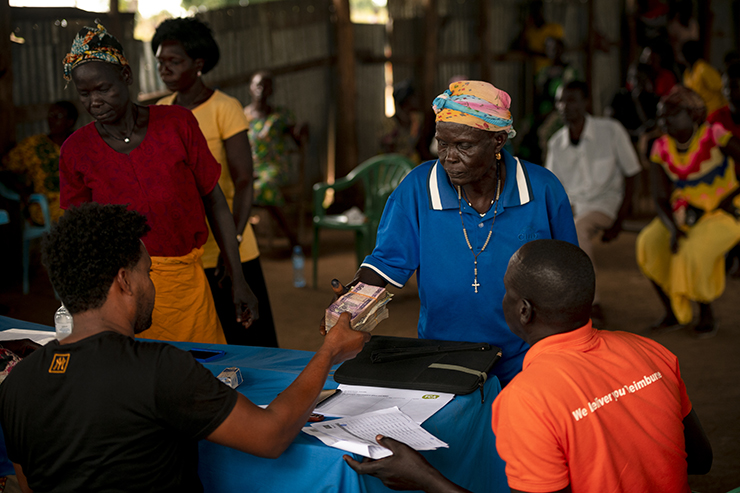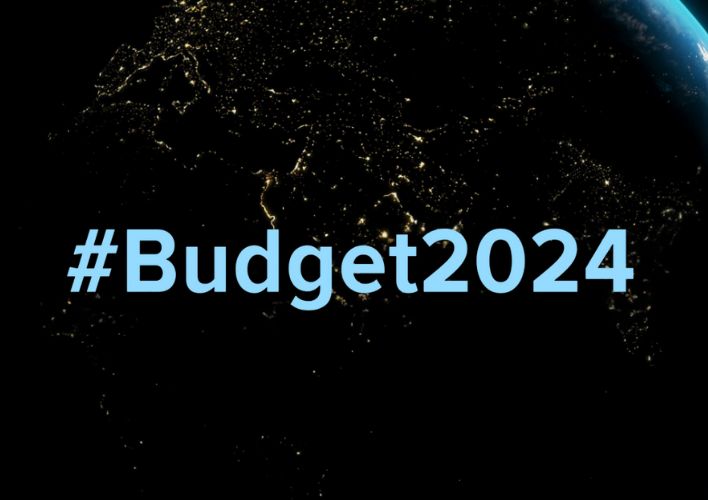When Foodgrains Bank was founded forty years ago, food assistance involved shipping Canadian grain around the globe. If you had visited the Foodgrains Bank offices during those early years, you would have found people with expertise in international logistics and shipping, enabling food to make the complicated journey from Canada to project locations around the world. The old maritime atlases and shipping directories in our office library are an artifact of this way of working.
A lot has changed since then. Foodgrains Bank was a leading advocate for purchasing food locally in the countries where we program. Providing locally purchased in-kind food transfers contributes to the local economies of countries where we support programming, reduces logistical complexity, and ensures that the food provided meets local dietary preferences.
Foodgrains Bank continues to procure a significant amount of food annually. Last year, we supported nearly $30 million of in-kind food assistance projects. While the foods provided by these projects vary widely, many provide a basic transfer of a staple grain (such as maize, wheat flour, or sorghum), a pulse, oil, and salt. I think this is what many people think of when they think of Foodgrains Bank’s food assistance work.
But in-kind assistance still involves the delivery of actual food items. Much of our programming has seen an even bigger shift: the adoption of cash and voucher assistance. Since we funded our first cash assistance project a decade ago (a project in Afghanistan in 2013), our portfolio of cash programming has grown to approximately a third of our annual food assistance. Last year alone, we planned to reach 170,320 people with $20.9 million in cash programming.
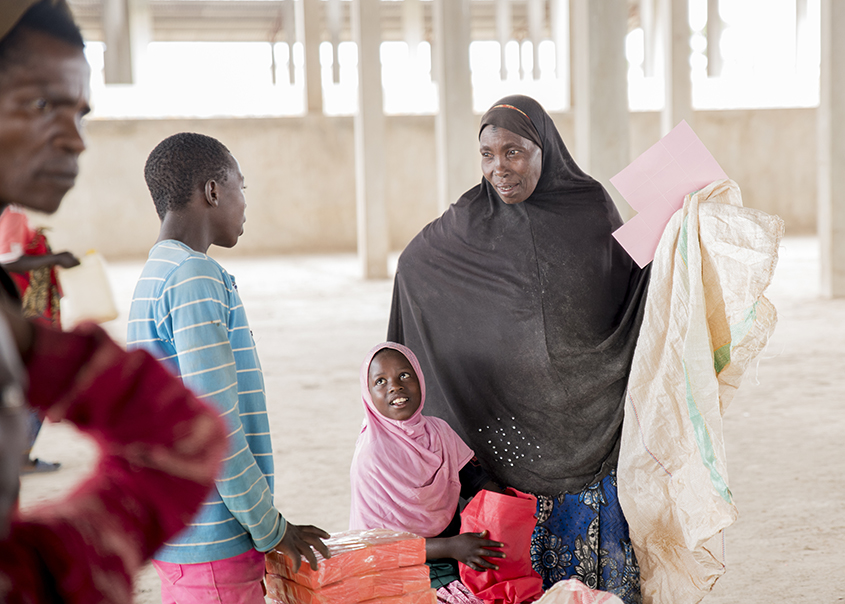
LWF Burundi, partner of Canadian Lutheran World Relief, provided vouchers for project participants and then organized market fairs in the communities so that people did not have to go far to use their goods and could purchase items at pre-negotiated prices. This photo was taken during a food fair in Ruyigi province. (Photo: LWF Burundi)
Why cash?
The shift to cash programming represents a broader shift within the humanitarian sector over the past 20 years. The Grand Bargain – an agreement between many of the world’s largest donor countries and aid providers that was launched in 2016 – includes a commitment to increase the use of cash-based programming. Many UN agencies and non-governmental organizations provide cash assistance for much of their programming. As a result, according to a report from the Cash Learning Partnership, approximately 21% of humanitarian assistance globally is provided through cash or vouchers.
There are many potential benefits to cash programming. In the right circumstances, cash can offer dignity and flexibility to people receiving assistance, enabling them to make decisions about what they want to purchase. Cash programming also ensures that money is spent and circulates in local markets in the communities where participants live, extending the positive impact of a project within a community. There are also logistical benefits to cash. In the right circumstances, it is possible to reach people more efficiently than in-kind assistance, which needs to be transported, stored, and distributed.
What is a good context for cash programming?
Foodgrains Bank does not push partners to use cash or in-kind assistance. We want responses to best meet local realities and, most importantly, the preferences of the people receiving assistance. When partners begin planning a project, they start by analyzing the local markets and the preferences of women and men (which are sometimes different) to understand which modality (type of assistance) is best suited for the context. They also coordinate with other organizations responding in a particular context to ensure that our response is similar to what others are already doing in an area.
Based on this assessment, a decision is made about whether to use cash, vouchers, or in-kind assistance. Cash or vouchers may be appropriate when markets are functioning and accessible to the people receiving assistance, when food is available at reasonable prices in the market, and when cash can be delivered safely to participants. In areas that are further from markets, where there is rapid inflation, or where markets are no longer functioning due to a crisis, in-kind assistance is likely more appropriate.
Cultural factors, particularly around the role of women and men in the household, also contribute to these decisions. Women are often responsible for food preparation, but men may be culturally responsible for cash. The ability to access markets may also be different for women and men.
The difference can be quite localized. For example, last year two projects were being planned at a similar time in Marsabit County in northern Kenya. One of these projects was close to town. The participants there had relatively easy access to a larger market centre where food was available at a reasonable price, and because of this, cash was chosen as the modality for that project. Not too far away, we supported an in-kind assistance project. The participants supported by that project lived further from any markets, and because they would need to travel a long way to use cash, receiving actual food items was the preferred form of assistance.
What do people use the cash for?
One of the biggest benefits of cash programming is that people can use the cash in ways their families most need. This is also a challenge for an organization like Foodgrains Bank, which has a particular focus on hunger. However, it is our experience that the vast majority – and in many cases nearly all – of the money provided to participants is used for food. If some of the money is spent on other things, it is typically on things like essential medicines, sending children to school, or investing in businesses (so that people will have income after the assistance ends). Based on our experience – and the evidence from across the whole sector – it is a misconception that recipients of cash use it to purchase alcohol, tobacco, or other products that do not contribute to household wellbeing.
For example, in Yei, South Sudan, a project participant named Esther Nyoka shared that after returning to South Sudan from Uganda, where she had spent years as a refugee, she had “nowhere to start and nothing to eat.” When she was selected as a participant in a project implemented by Finn Church Aid, Esther said: “It was a big relief… the cash greatly helped the health of my children and my family. We were able to buy food items from the local market to save the family from hunger.”
In Pakistan, Hafiza Bibi received three transfers of 12,000 Pakistani rupees (around $70 Canadian dollars) after flooding in Pakistan. Hafiza shared that she “bought essential food items such as wheat flour, rice, sugar, tea, milk, and vegetables. This assistance has provided me some relief and allowed me to put food on the table for my children.”
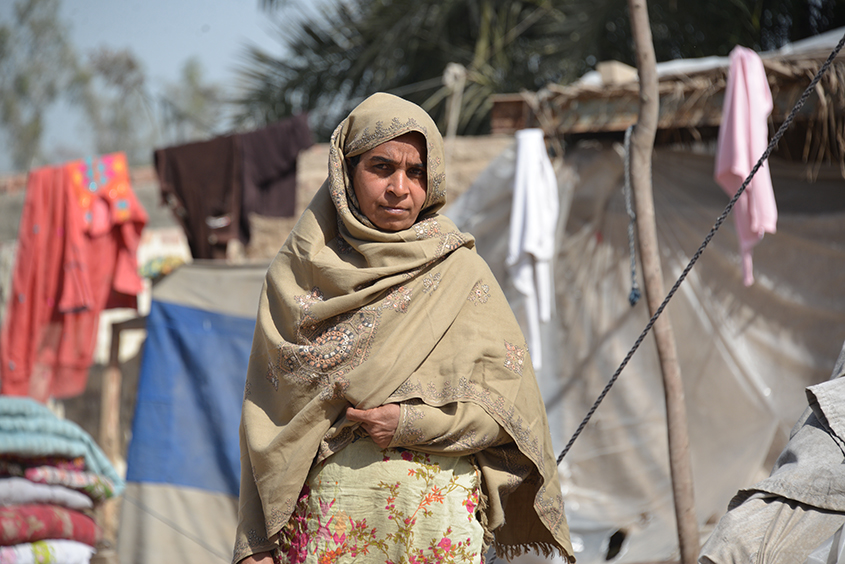
After devastating floods destroyed her house, Hafiza Bibi stands before the makeshift tent where she and her four children now live. (Photo: CWSA)
Some projects simply provide cash assistance, while others incorporate other components to help encourage participants to spend the money on healthy food. For example, a partner in Nigeria provides training for participants on proper feeding for infants and young children. The thinking is that providing this training alongside cash assistance will encourage people to spend the money they receive on healthy food. In other projects, partners also work to support livelihood activities alongside the cash transfers. The cash meets immediate household needs, while other project components begin to address longer-term food security.
How much cash is given?
The size of a cash transfer is determined locally and can change over time as situations improve or deteriorate, and as food prices rise and fall.
In many of the places we work, there are coordinating mechanisms between agencies that help establish common recommendations for the size of cash transfers. Recommendations are typically based on evidence of need and the cost of food. In many countries, the Minimum Expenditure Basket (a tool used to calculate, in a specific place and time, the average cost for a vulnerable household’s basic needs) is analyzed. Additionally, in some cases, governments regulate the size of transfers.
These recommendations differ from country to country and even within the same country. For example, a recent project in Somalia provided $90 USD per household in one region and $100 in another, due to differences in food prices between communities. These amounts are typical of our recent cash assistance programming. In the last year, most projects have provided either $90-100 US dollars (USD) per household per month or $15-20 per person.
One of the advantages of cash transfers is that it is easier to adapt the size of the transfer to the number of people in a household than it is for in-kind assistance, which tends to be provided as a set amount of food per household. For example, a project in South Sudan is providing $18 USD per person per month (up to eight people per household) – so a household of two people receives $36, while a household of seven would receive $126.
Many countries where we provide cash transfers experience rapidly changing currency rates. In these cases, partners often set their transfers based on the US dollar. The dollar value remains the same every month, but people receive their transfer in the local currency, which fluctuates based on the value of the currency. This helps people keep up with the rapid currency devaluation and price inflation that is being experienced in places like South Sudan.
How is cash delivered?
There are a few ways that Foodgrains Bank partners deliver cash to project participants, the most common being the distribution of physical cash, bank transfers, and mobile money transfers.
The distribution of physical cash works well where people have limited access to technology or formal financial institutions. Currently, we are distributing physical cash in countries like Malawi, DR Congo, and South Sudan. In most cases, the partner will work with a reputable financial service provider to do the distribution – particularly given the security issues of transporting and distributing large volumes of cash.
Bank transfers are less common, as in many contexts where we support programming, people do not have access to banks or have bank accounts. One country where bank transfers were possible this past year was in Ukraine. After participants were selected, they received the assistance directly transferred into their bank accounts and could then access the money through ATMs or bank branches.
One of the most common forms of cash transfer that we undertake is through mobile phones. In many countries, people can receive money and pay for goods and services using their phones. Right now, we are using mobile transfers in places like Kenya, Somalia, and Pakistan. Once account details have been collected, partners can link through mobile money networks to send bulk payments to thousands of households with a few clicks of a mouse – making mobile money transfers a very efficient way to send funds.
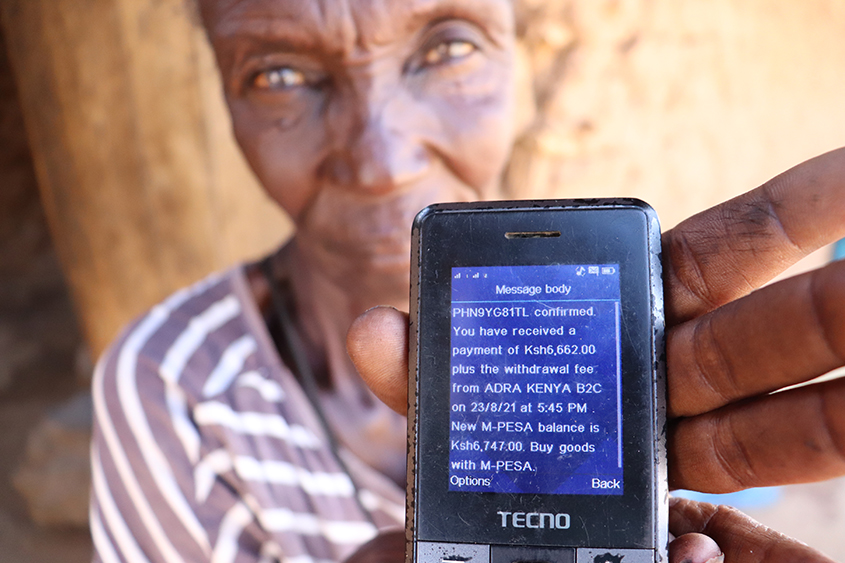
In Turkana, Kenya, Namoti Buo Longoi receives funds through mobile money app Mpesa as part of her participation in an ADRA program. (Photo: ADRA Kenya)
When I visited a project in Kenya that sent funds to participants through Mpesa (a cellphone-based system to receive money and pay for products), participants shared about a number of benefits. The transfers were convenient as participants did not have to show up at a certain place and time. The transfers were also safe for participants since they did not have to walk around with cash, and for the project, as cash did not need to be brought to a central distribution point. And the transfers were discreet – no one else knew that they had received money.
Mobile money is not without challenges. Sometimes people do not have phones or accounts, and project teams are tasked with helping set these up. In some cases, women have far less access to mobile phones than men. There are also cases where electricity and network connectivity can be a challenge, making it difficult for people to charge their phones or access funds this way.
Does Foodgrains Bank fund vouchers?
Yes! Foodgrains Bank also funds voucher projects in a number of countries ($6.6 million of programming which reached 29,500 people last year). Vouchers have varying levels of restrictions on them. Some allow you to only purchase certain items. Others allow the participant to have significant choice when shopping at selected retailers (acting, essentially, as a gift card would in the Canadian context). Many of the same benefits of cash – dignity, flexibility, and convenience – are largely similar with voucher programming.
There is some additional administrative work to voucher programming, as it requires the partner to work with the vendors where vouchers can be used to explain any restrictions up front, put in place a system (electronic or paper) for payment using vouchers, and pay the vendors for items purchased. However, it is also easier in voucher programming to ensure that only particular items (such as food) are purchased.
Voucher approaches can be tailored to meet the areas where they work. In Lebanon, we have worked with partners providing pre-loaded cards that participants can use at a major grocery chain to purchase food. In Burundi, a partner I worked with provided vouchers to participants and then organized market fairs to bring vendors together at one place and time to sell their products. This brought the market closer to where participants lived (saving people time and expense to get to the market) and meant that the partner could pre-negotiate prices with vendors to ensure participants got a fair price.
In some cases, vouchers are a bit more restrictive – allowing participants to purchase certain amounts of certain products. For example, a partner in Somalia has provided a voucher to families with children receiving treatment for malnutrition. This voucher allows the family to purchase a set basket of food items from shops at the local market and is intended to prevent children who had been treated from relapsing after they go home.
What’s most important in the way we program?
Ultimately, what is most important is that we listen to the people who are experiencing crisis, and provide assistance that is respectful, convenient, accessible, culturally appropriate, and takes into account their preferences. Foodgrains Bank continues to work with our members and their partners to ensure that our food assistance programming – whether provided through food, cash, or vouchers – does this. While in-kind assistance is (and will likely remain) critical in many places where we support programming, cash provides us with a helpful tool to fulfill our mission of ending hunger.
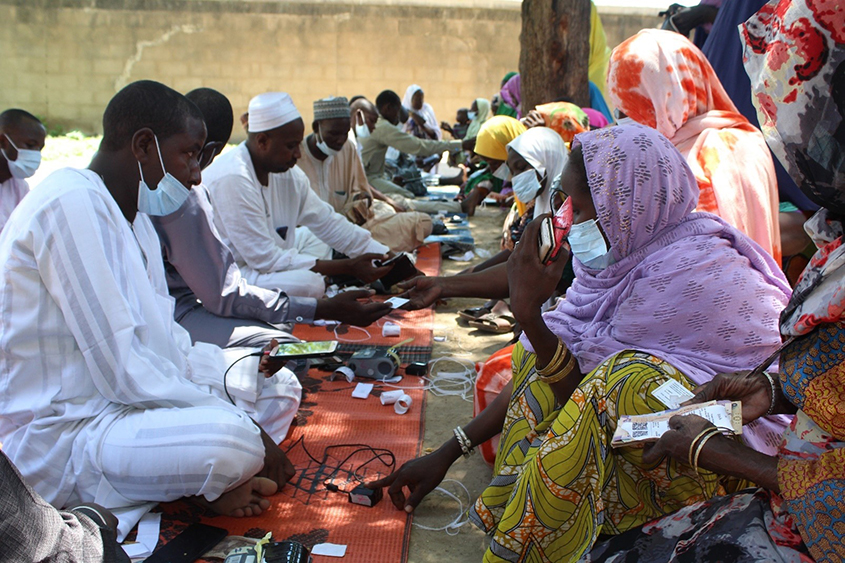
Participants receiving their cash from local partner ZOA at a distribution in Nigeria, supported by our member World Renew Canada. (Photo: ZOA)
